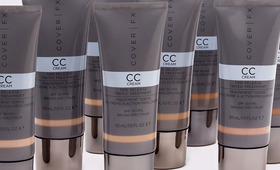How to Find Your Undertone and Choose the Right Foundation
by Jill Russell
Published Aug 2, 2013

Finding the right shade of base to match your complexion always seems like a daunting task. And according to Jamie Greenberg, a celebrity makeup artist for Mark., most of us aren’t wearing the right color anyway. Often foundations and concealers prompt you to choose a shade based on your undertone, especially when shopping online. But if you don’t know what your undertone is, that isn’t much help!
An undertone is the color that's just beneath the skin, and while your skin tone can change (over time, with sun exposure, etc.), the undertone does not. Foundations usually come recommended for one of three undertone types: “cool,” “neutral,” or “warm.” It’s possible, though, to fall somewhere in between (you could be “neutral-warm,” for instance). To get you closer to finding the perfect match, we asked Greenberg to outline how to figure out your undertone. Note, these same principles apply on all skin tones, from very fair to dark. And remember, if you're having trouble DIY’ing it, you can always ask a professional makeup artist for a skin analysis.

Those with cool undertones will notice their skin has a pink, red, or blue tinge to it.
You have a “cool” undertone if:
• If the veins on your wrist are blue or purple
• If silver jewelry flatters your skin more than gold
• When you look at your skin in the sun, it appears blue-ish

If you have neutral undertones, your skin is neither pink/red/blue nor yellow/gold/peach, but somewhere in between.
You have a “neutral” undertone if:
• The veins on your wrist are blue-green
• Both gold and silver jewelry flatter your skin
• When you look at your skin in the sun, it appears greenish

Those with warm undertones will notice their skin has a yellow, gold, or peach tinge to it.
You have a “warm” undertone if:
• The veins on your wrist are slightly green or olive
• Gold jewelry flatters your skin more than silver
• When you look at your skin in the sun, it appears yellowish
Three More Tips for Finding the Right Foundation
So now you know your undertone, you can start to narrow the field. If you’re trying foundations in a store, here are Greenberg’s three tips to help you find the right one.
1: Prep Skin First
Before you do anything, exfoliate and moisturize your skin. “Slough off those dead skin cells and prepare that canvas so it can honestly accept color,” says Greenberg. “If your skin is sweaty or isn't totally clean, the color won't be accurate!”
2: Test in Good Lighting
Make sure you test your foundation in good lighting. It's always a good idea to first test it out in one location, and then go somewhere else with different lighting to see if it still matches. And make sure you're wearing white, as other colors might alter your tone. Greenberg warns that you should never try to correct your color with a base. “It's best to match your undertone, and then if you feel pale, you can always add bronzer or blush for dimension,” she says.
3: Match The Color You See Most
There are three parts of the body you have to think about: the face, the neck, and the décolletage—and Greenberg points out that all of these can differ. “The most natural thing would be to match your neck, but because of sun exposure and elements, the face/décolletage are often darker than your neck,” she says. To even things out, Greenberg suggests choosing a product that matches the color you see the most, and then applying base to the face and neck so that you get even color all over.
You Might Also Like
-

BB Creams
All You Need to Know About BB Creams
- 1966
-

Interviews
Your Perfect Foundation, Found!
- 592
-

Bronzer
Best Blush and Bronzer Duos
- 103
-

Foundation
Cover FX Custom Cover Drops: Foundation Will Never Be The Same
- 491
-

Bronzer
Easy Summer Looks With Cream Blush and Bronzer
-

Bronzer
10 Best Bronzers & Highlighters for Brown Skin
- 2







